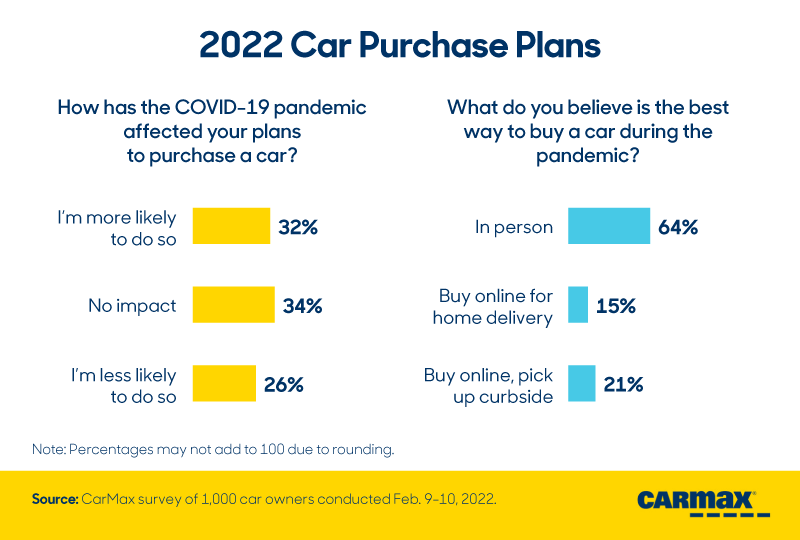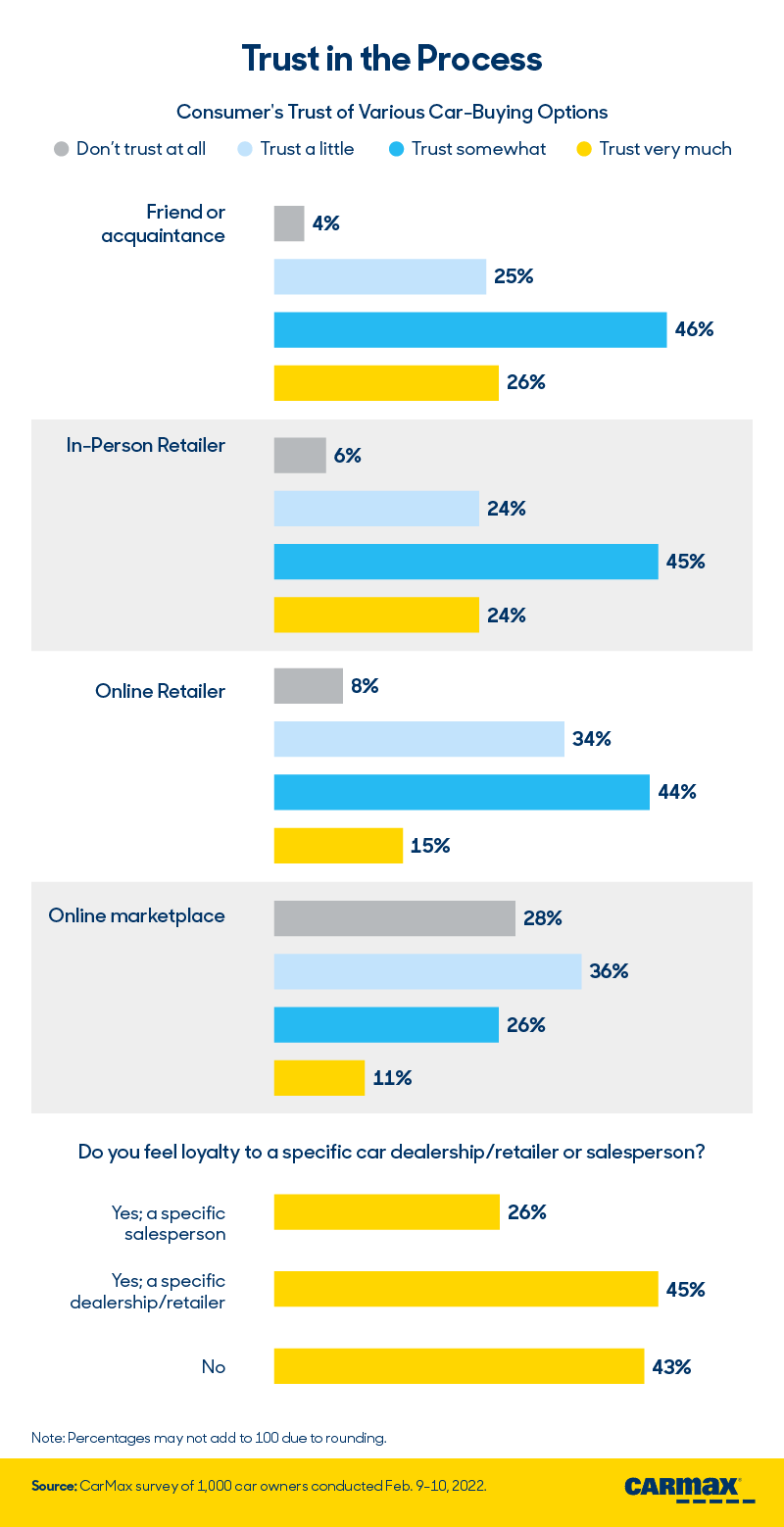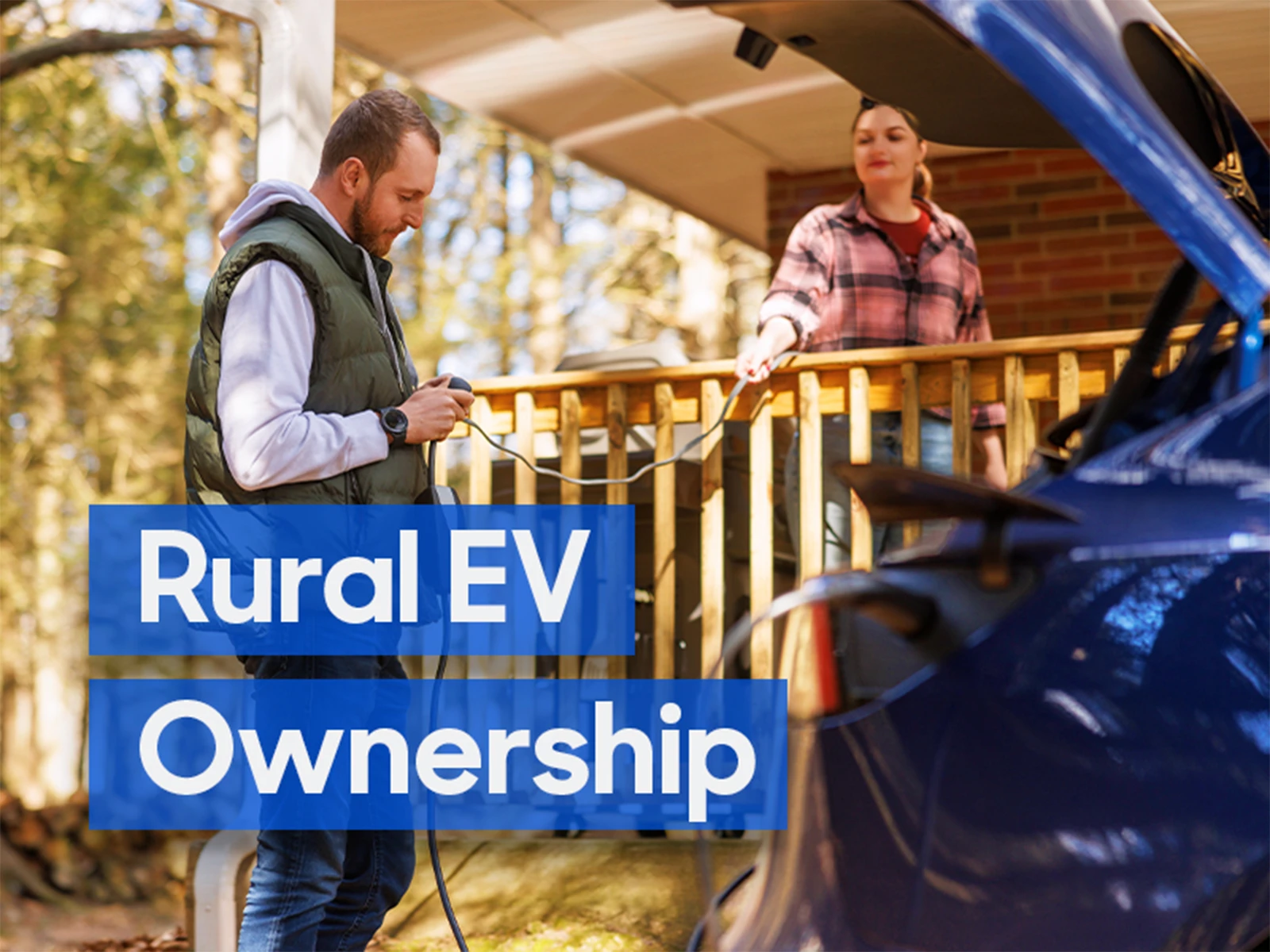
Highlights:
35% of respondents surveyed plan to purchase a used car in 2022
36% of respondents said they’d be comfortable buying their next car online for home delivery
29% of respondents said they feel loyalty toward a specific car dealership or retailer when looking to buy a car
Respondents in their 30s were the most likely to buy used cars
The COVID-19 pandemic led to new ways of buying even the most basic of goods: Groceries were delivered to doorsteps, online orders skyrocketed, and curbside service became a norm for restaurants and major retailers. The auto industry was no different, with dealerships, retailers, and consumers all shifting to different practices. To learn more about perceptions of the ongoing transformation of the car-buying process, we surveyed over 1,000 car owners currently living in the U.S. between February 9 – February 10, 2022. Note, this survey was conducted before the increase in gas prices nationwide.
We looked at how the pandemic impacted car owners’ plans for buying their next car. Respondents also offered insights on their most recent vehicle purchase experience, their trust levels when buying a car, and different buying methods they would be open to for their next purchase.
Gauging Interest

For the car owners surveyed, 32% said the pandemic has made them more likely to buy another car and 64% said they believe the best way to buy a car during the pandemic is
in person.

The survey also revealed that 35% of respondents plan on purchasing a used car in 2022, and 1 in 5 respondents reported they were looking for a car priced between $20,001-$30,000.
Likewise, respondents looking for a car were most likely to lean toward Honda (24%), with Toyota (19%) and Hyundai (16%) in second and third. Overall, these shoppers were also most likely to be looking for an SUV or crossover (45%), with sedan shoppers following just behind (30%). It’s important to note, however, that respondents were not required to choose just one brand and were instead asked to select all the brands they were considering.
Car-Buying Trends
Buying a car is a substantial purchase with a variety of factors. Next, we asked participants to break down their most recent car buying experience.

When asked about their most recent car purchase, 67% of respondents had bought new cars and 33% purchased used. Interestingly, respondents in their 30s were more likely to have gone the used route, whereas other age groups opted more frequently for a new car.
In addition, most respondents purchased their recent vehicle at an in-person dealership or retailer, with 51% of respondents reporting this method of purchase. Similarly, when looking at other aspects of the shopping journey, 53% of respondents were preapproved for a loan before speaking to a car dealership or retailer, and respondents spent an average of 5.3 weeks researching before purchasing their most recent vehicle.
Thoughts on Trust
When making a big purchase, it’s helpful to have access to trusted guidance. The following section of the survey explores respondents’ trust and comfort with the car buying process.

When asked about their comfort level with different car buying options, the survey results showed more than half of respondents (59%) saying they trust buying a car online from a retailer, either somewhat or very much. Along the same lines, when asked about feeling loyal to a specific car dealership/retailer or salesperson, only 26% said they are loyal to a specific person, 45% reported feeling loyal to a specific dealership/retailer, and 40% stated they don’t feel loyal to either.
Purchasing Methods of the Future
The COVID-19 pandemic has changed consumer behavior in a lasting way. More than ever, customers are open to changing how they shop for cars which sparked our curiosity to learn more about what other emerging methods of car buying piqued consumer interests. In the chart that follows, we explore what purchasing methods consumers are comfortable using for car shopping.

When it comes to newer methods of car buying, respondents expressed comfort with the idea of blended online and in-person methods: 38% would be comfortable ordering a car online for home delivery, and 44% said they’d be comfortable ordering online for curbside pickup at a dealer or retailer. Fewer respondents were interested in the more niche methods, such as augmented reality testing (24%) and subscription ownership (23%). It’s increasingly clear that customers are looking for flexibility in how they’re able to buy a car.
The Car-Buying Landscape
This coming year, thousands of people will be looking to purchase a car, and the pandemic even strengthened that likelihood for some. If previous purchases are any indication of future behavior, there will be a mix of people looking for new and used vehicles, buyers won’t necessarily feel loyalty toward a salesperson or dealership/retailer, and consumers will be interested in some newer buying methods, particularly the option to buy cars online. At CarMax, we understand people have different ways they want to shop for their next car. With test drive options and the ability to browse our selection of cars online, CarMax is here to help you find your next vehicle. Head to CarMax.com to learn more and to shop our online inventory now.
Methodology
We surveyed 1,000 current car owners in the U.S. about their plans for purchasing a vehicle in the future and their past purchasing experiences. Both surveys were of the general population and not limited to CarMax customers. Respondents ranged in age from 19 to 76 with an average age of 40. The survey was conducted from February 9 – February 10, 2022.
Limitations
The data we are presenting relies on self-report. There are many issues with self-reported data. These issues include, but are not limited to, the following: selective memory, telescoping, attribution, and exaggeration.
Fair Use Statement
After an unprecedented year, the car-buying process is quickly evolving. If someone you know would benefit from the information in this project, you may share for any noncommercial reuse. We ask that you link back here so the entire project and its methodology can be reviewed. This also gives credit to our hardworking contributors, who make this work possible.




